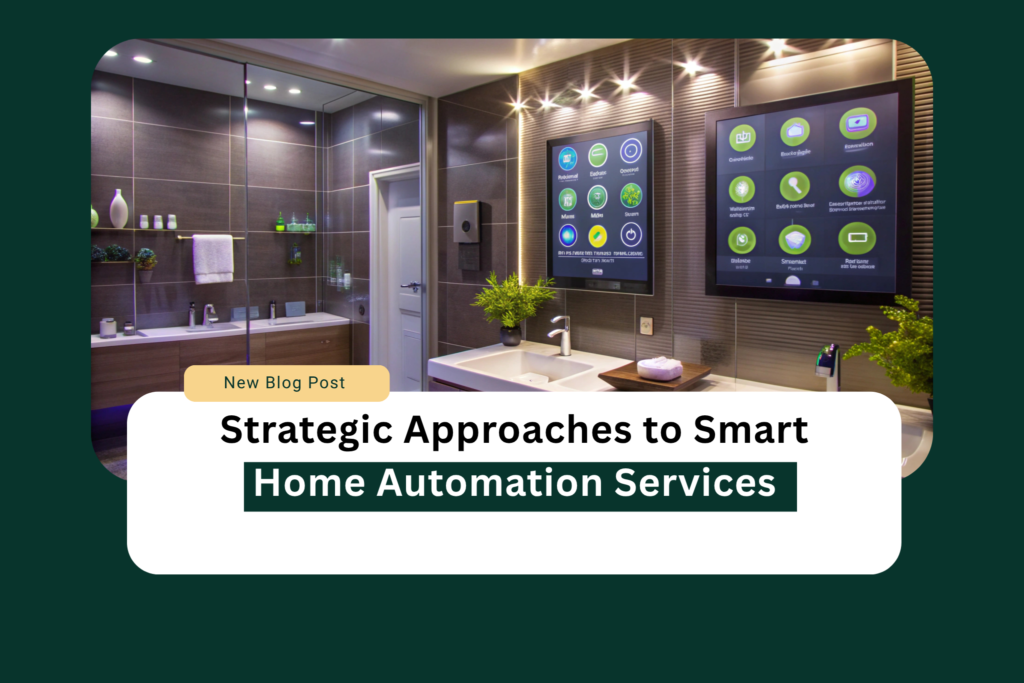Introduction
The smart home automation services industry stands as a highly promising sector in modern technology due to Fortune Business Insights projecting a global market value of $622.59 billion by 2026. The successful capitalization of this rapid market expansion depends on businesses creating detailed strategies for smart home automation services. The emerging market presents exceptional business possibilities to providers who can master consumer requirements and technological unification obstacles as well as market segmentation. This article investigates the methods businesses need to succeed in advancing smart home automation infrastructure.
Understanding the Market Landscape
Businesses need to analyze the present status of smart home automation services before starting their strategy development process. The 2024 Parks Associates survey reveals that smart home device ownership has reached 43% among US households while experiencing a 12% growth since 2022. The explosive market acceptance generates excellent business potential yet increases market competition.
The first step requires extensive market analysis to discover customer segments without adequate service and their specific requirements. The smart home market contains multiple sectors which include security systems together with entertainment features and energy management solutions along with health monitoring capabilities. The market segments display specific opportunities together with their distinct difficulties.
Building Your Service Portfolio
Smart home automation service providers achieve their best success by creating solutions that combine advanced technology with easy-to-use implementation methods.
Your second step should develop different service levels which serve diverse customer groups. Research conducted by Statista demonstrates that security is the main reason consumers choose smart home technology with 78% of adopters while convenience features drive 67% of smart home users. The service portfolio needs to demonstrate these priorities through scalable solutions.
Smart home automation services require integration to form their central design principle. The average US household that uses smart technology has increased its connected devices from 11 in 2022 to 14 in 2024 based on Deloitte’s 2024 Digital Media Trends survey data.
Creating a Competitive Edge
The rapidly growing smart home automation market requires providers to establish unique features for market differentiation.
During Step 3, you should determine your exclusive selling point in the smart home automation marketplace. Success in the market depends on providers selecting particular areas where they can excel instead of trying to reach every customer segment.
According to the Consumer Technology Association’s 2023 study, about 72% of consumers consider privacy as their primary consideration when choosing smart home services, yet these services, which prioritize data, achieve superior market performance.
Developing Strategic Partnerships
Smart home technology requires businesses to establish partnerships because of their interconnected structure.
The fourth step requires companies to establish connections with hardware producers and software developers as well as providers of complementary services. Research data from McKinsey indicates that businesses that build at least three strategic partnerships achieve 34% better revenue growth than single-operator firms.
The partnerships should strengthen your smart home automation services by providing better integration features, extended functionality, and new market access to different customer groups. Assess how your service products can work well with other systems yet keep your specific identity intact.
Setting Up Operational Infrastructure
Excellent smart home automation services depend on effective operational systems. Technical infrastructure, along with training programs and customer support systems, require investment as part of Step 5. Research from Field Service News indicates that remote diagnostic tools cut service calls down to 60% of their original numbers.
Your operations need to maintain both scalable features and individualized solutions. Standardized processes enable efficient growth, yet smart home environments need customized approaches because they differ widely from household to household.
The Process of Promoting Your Smart Home Automation Services
Marketing techniques need to showcase both the technical abilities and useful advantages of the products.
Step 6 requires you to create messaging that demonstrates how your smart home automation services effectively solve actual problems.
Businesses should concentrate on results such as convenience security energy savings and enhanced quality of life instead of focusing solely on technical specifications. You should establish demonstration facilities that let potential customers test your smart home automation solutions directly. When companies implement experiential marketing techniques they achieve a 40% boost in conversion rates among customers in the home technology market.
Measuring Success and Evolving
Your smart home service strategy needs regular updates because this market sector changes at a quick pace. You should create performance indicators that specifically support your business targets during Step 7. Your performance monitoring should evaluate financial data and measure customer satisfaction alongside retention rates referral volume and ecosystem growth through additional customer service adoption.
Regular assessment of your smart home automation service insights will help you develop better versions of your service. ServiceMax research shows that technology service companies that conduct quarterly strategy assessments retain their customers at 27% higher rates.
Conclusion
The fast-growing smart home market will reward companies that develop effective smart home automation services strategies because they will secure meaningful market share. Service providers can succeed in this evolving marketplace by studying consumer needs then developing adaptable service packages forming key alliances and keeping their operations at peak performance.
To develop successful smart home automation services one must merge technological innovation with human-centered design principles. The providers who succeed in the smart home market will combine trustworthy operations with genuine value delivery to their customers.
Your input regarding smart home automation service experiences is highly appreciated. Do you utilize any of these business approaches in your operation? Post your ideas in the comments section for others to read and remember to distribute this article to colleagues who can benefit from this information.
FAQ
What is the typical return on investment from deploying smart home automation services? Most homeowners recoup their automation investment between 2-3 years because of reduced energy bills (by 15-30%) and enhanced property value (with a 3-5% premium added).
What smart home devices do consumers adopt the most?
Smart speakers (52%), security cameras (36%), smart thermostats (23%), and smart lighting (19%).
Are professional installation services necessary?
Professional installation stands above DIY alternatives when consumers need help combining complex smart home systems since 64% of consumers choose this option.
How secure are the systems used to manage smart homes?
The security level of smart home systems differs across providers, so users should choose providers that offer end-to-end encryption with regular security update releases.
What’s the average monthly cost?
A5: $10-50 depending on services included.
Read More : https://theacechronicle.com/home-and-office-interior-styling-plan/








